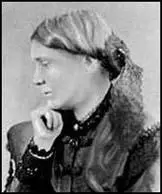Emily Blackwell

Emily Blackwell was born in Bristol, England, on 8th October, 1821. When Emily was eleven years old the family emigrated to the United States. Samuel Blackwell was strongly opposed to slavery and after meeting William Lloyd Garrison, became involved in Abolitionist activities. When her husband died in 1838 Hannah Blackwell had nine children to look after.
Emily's sister, Elizabeth Blackwell, became the first woman in the United States to qualify as a doctor. Emily followed her example and after being rejected by ten medical schools was accepted by the Rush Medical College in Chicago. However, in 1853, when male students complained about having to study with a woman, the Illinois Medical Society vetoed her admission. Soon afterwards Emily managed to get accepted by the Western Reserve University in Cleveland.
After graduating in 1854 Emily continued her studies in Edinburgh, Paris and Berlin. She returned to the United States in 1856 and found work with Elizabeth Blackwell in New York. In 1857 the Blackwell sisters and Marie Zakrzewska established the New York Infirmary for Women and Children. The women gave public lectures on hygiene, created a health centre, appointed sanitary visitors and campaigned for better preventive medicine.
During the American Civil War Emily helped organize the Women's Central Association of Relief. This involved the selection and training of nurses for service in the war. Emily, along with Elizabeth Blackwell and Mary Livermore, also played an important role in the development of the United States Sanitary Commission.
After the war the Blackwell sisters established the Women's Medical College in New York. Emily became professor of obstetrics and when Elizabeth Blackwell moved to London to help form the London School of Medicine for Women, Emily became dean of the college. By 1899 the college had trained 364 women doctors.
Emily Blackwell worked with the New York Infirmary for Women and Children until her death in York Cliffs, Maine, on 7th September, 1910.

